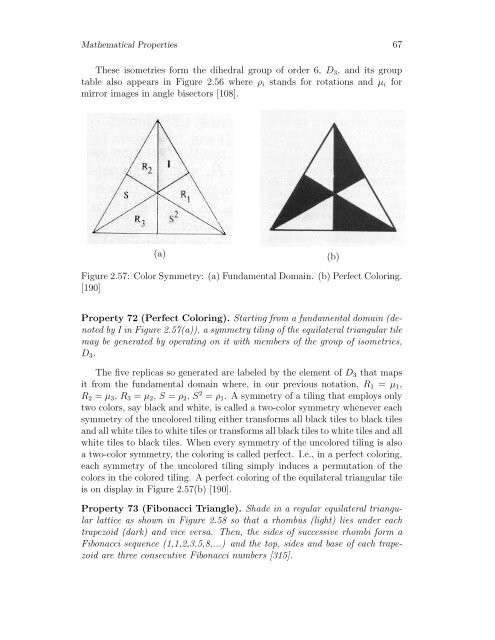MYSTERIES OF THE EQUILATERAL TRIANGLE - HIKARI Ltd
MYSTERIES OF THE EQUILATERAL TRIANGLE - HIKARI Ltd
MYSTERIES OF THE EQUILATERAL TRIANGLE - HIKARI Ltd
Create successful ePaper yourself
Turn your PDF publications into a flip-book with our unique Google optimized e-Paper software.
Mathematical Properties 67<br />
These isometries form the dihedral group of order 6, D3, and its group<br />
table also appears in Figure 2.56 where ρi stands for rotations and µi for<br />
mirror images in angle bisectors [108].<br />
(a) (b)<br />
Figure 2.57: Color Symmetry: (a) Fundamental Domain. (b) Perfect Coloring.<br />
[190]<br />
Property 72 (Perfect Coloring). Starting from a fundamental domain (denoted<br />
by I in Figure 2.57(a)), a symmetry tiling of the equilateral triangular tile<br />
may be generated by operating on it with members of the group of isometries,<br />
D3.<br />
The five replicas so generated are labeled by the element of D3 that maps<br />
it from the fundamental domain where, in our previous notation, R1 = µ1,<br />
R2 = µ3, R3 = µ2, S = ρ2, S 2 = ρ1. A symmetry of a tiling that employs only<br />
two colors, say black and white, is called a two-color symmetry whenever each<br />
symmetry of the uncolored tiling either transforms all black tiles to black tiles<br />
and all white tiles to white tiles or transforms all black tiles to white tiles and all<br />
white tiles to black tiles. When every symmetry of the uncolored tiling is also<br />
a two-color symmetry, the coloring is called perfect. I.e., in a perfect coloring,<br />
each symmetry of the uncolored tiling simply induces a permutation of the<br />
colors in the colored tiling. A perfect coloring of the equilateral triangular tile<br />
is on display in Figure 2.57(b) [190].<br />
Property 73 (Fibonacci Triangle). Shade in a regular equilateral triangular<br />
lattice as shown in Figure 2.58 so that a rhombus (light) lies under each<br />
trapezoid (dark) and vice versa. Then, the sides of successive rhombi form a<br />
Fibonacci sequence (1,1,2,3,5,8,...) and the top, sides and base of each trapezoid<br />
are three consecutive Fibonacci numbers [315].

















